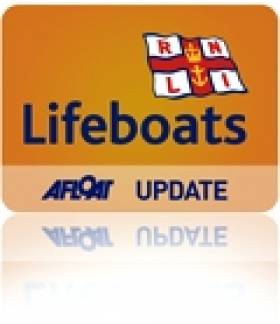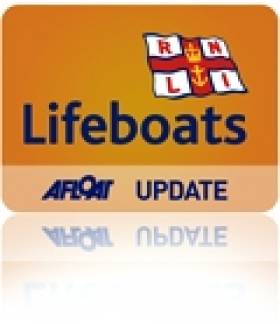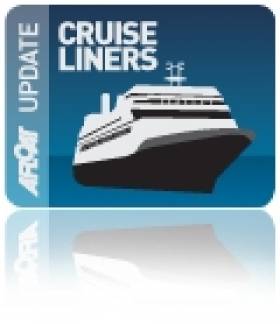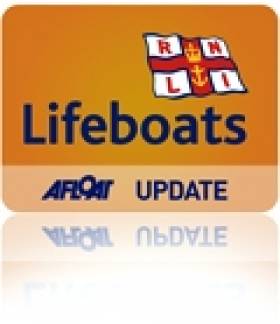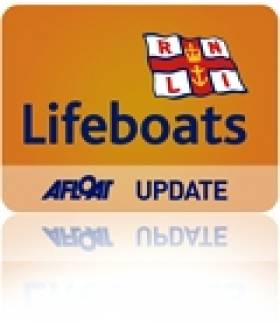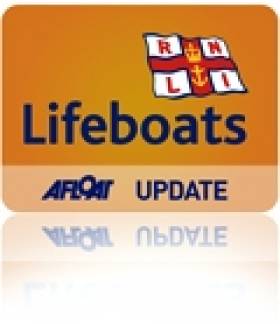Displaying items by tag: Lifeboats
Skerries RNLI Aids Stranded Powerboat
#RNLI - Skerries RNLI went to the assistance of two people whose powerboat got into difficulty off the Balbriggan coast in north Co Dublin yesterday.
Shortly after 6pm last night (Tuesday 19 February) the station’s volunteer lifeboat crew was requested to launch after the alarm was raised by gardaí that a 4-metre speed boat was in difficulty just off Hampton Cove in Balbriggan.
The boat, which was approximately three miles out from Skerries, had fouled its propeller.
Weather conditions at the time were described as cold and dusk was settling into dark.
The Skerries RNLI crew put to sea accompanied in the air by the Irish Coast Guard helicopter, which had been on exercise locally.
Arriving on scene, it became apparent that the two people on board had managed to paddle their boat safely to the shoreline. The Skerries lifeboat crew proceeded to tow the speedboat back safely to Balbriggan Harbour.
Skerries RNLI Crew Shadows Ambulance Teams in Unique Learning Experience
#RNLI - Skerries RNLI volunteer crew recently undertook an exercise the likes of which they had not done before - shadowing a local ambulance team to observe how they respond to emergencies.
Philip Ferguson, a Skerries RNLI crew member, is also an advanced first responder with the local Dublin fire brigade. He has been on many sea rescues and call outs, and though not all have resulted in an ambulance being called to the scene, there are always those incidents that do require their specialist services.
In this regard, Ferguson believed that for the local lifeboat crew to witness how the ambulance teams operate would provide invaluable experience to the crews.
He approached Skerries RNLI lifeboat operations manager Niall McGrotty and divisional operations manager Owen Medland with his idea to discuss the possibility of some of the local RNLI crew joining the ambulance teams on some of their shifts in an observational capacity. They would not be allowed to take part or assist the HSE crew at any point, they were there to look and learn.
Both agreed that it was an exercise worth pursuing, and an arrangement was then made with the local HSE ambulance base in Swords. Over a period of three weeks, all of the RNLI crew took either a day or a night shift with the HSE ambulance crews. As the ambulance teams were called out, the RNLI volunteer rode along in the ambulance, observing the HSE teams at work be it at roadside after car crashes or to the homes to which they were called.
They witnessed first-hand the long hours and the dedication put in by the HSE ambulance teams as they waited in A&E at hospitals and transported their patients with care. Each individual who went on the exercise said it was, without doubt, an enlightening experience.
They also witnessed the professionalism of the HSE ambulance crews in sometimes very difficult circumstances. They saw how the ambulance crews worked with each other, their partners, and how they did their utmost to provide care and attention to the patient as they reviewed the situation, analysed the needs of the patient and did what was necessary to stabilise and transport that individual to hospitals. Each of the RNLI crew who went on the training came back with renewed and utmost respect for the ambulance crews.
The RNLI volunteer crew has not yet had to put their latest training to the test in 2013. However, with the knowledge they gained on the observational placements, they have added to their skills.
Such was the success of this exercise between that it is hoped it can be repeated. Skerries RNLI would like to thank each of the HSE ambulance crews for allowing them to spend time with them and learn.
Portrush Lifeboat Rescues Stranded Kayaker
#RNLI - Portrush RNLI has rescued a kayaker who got into difficulty off the Co Antrim coast.
The volunteer lifeboat crew had an early call out on Sunday morning (17 February) to the kayaker who got into trouble on the water at West Bay.
There were strong southerly winds at time which caused a swell. The kayak capsized and was whipped by the prevailing wind into the harbour area, leaving the kayaker stranded and treading water.
A Portrush lifeboat crew member who witnessed the scene on the West Strand spotted the incident and promptly raised the alarm.
The inshore lifeboat crew - including Mark Mitchell as helm, Andy McClelland and Stevie Ritchie - launched within minutes and had the kayaker back at base within 20 minutes.
Portrush RNLI lifeboat operations manager Robin Cardwell said: "The kayaker was very fortunate as the winds were quite strong in the West Bay. Our volunteer crew launched quickly and was able to bring him back to shore safely."
Search for Missing Spanish Fisherman Off Southwest
#Coastguard - The Irish Coast Guard's Rescue 115 helicopter was tasked overnight to search for a missing Spanish fisherman who fell overboard from his fishing trawler off the southwest coast in the early hours of this morning.
98FM is reporting the latest news on this incident, saying that the man went into the sea some 25 miles off Mizen Head.
The alarm was raised around 4am and the coastguard station at Valentia is co-ordinating the search and rescue effort, with RNLI lifeboats from Baltimore and Castletownbere in West Cork assisting.
Five Die In Canary Island Cruise Ship Lifeboat Drill
#CruiseLiners - The Guardian reports that five crew members on a British-operated cruise liner in the Canary Islands have died after a lifeboat fell 17 metres from the side of the ship and overturned during an emergency drill.
The crew - believed to include Indonesians, a Filipino and a Ghanaian - are thought to have been on board the lifeboat as it was being lowered from the vessel at the time of the incident.
Lifeboat launch drills are notorious for accidents, according to seafarers' union Nautilus International, who added that "there's been research which suggests that more people are dying in lifeboat drills than are being saved by lifeboats."
The Canary Islands are a popular holiday destination for people from Ireland and all over Europe seeking some winter sunshine. Reports say 2,000 passengers were on the cruise ship at the time but none were involved in the emergency drill.
The Guardian has much more on the story HERE.
Rosslare RNLI Launches To Drifting Vessel In Severe Winds
#RNLI - The volunteer lifeboat crew with Rosslare Harbour RNLI launched at 10.30am on Wednesday morning (6 February) to a fishing vessel drifting dangerously close to the shore in a force 8 gale (see video below).
The vessel was located about a mile from the lifeboat station in Rosslare Harbour and the lifeboat was on scene within minutes.
Two volunteer lifeboat crew were transferred to the drifting vessel whose moorings were unable to hold due to an unexpected change in the wind direction, and brought it under control in severe weather conditions.
The vessel was brought safely to the main harbour and secured. The callout last just over two hours.
Commenting on the callout, Rosslare Harbour RNLI deputy launching authority David Maloney said: "Weather conditions this morning in Rosslare Bay were very challenging and the crew showed great skill in bringing the vessel to safety.
"If the lifeboat had not launched, I have no doubt that the vessel would have been washed ashore."
'Fact Finders' Visit Dun Laoghaire RNLI for RTÉ's 'Elev8'
#RNLI - Dun Laoghaire RNLI will feature on RTÉ‘s youth programme Elev8 next week.
A number of the lifeboat station’s volunteer crew took time out on Monday to spend the afternoon filming a segment for the show, which will be broadcast at 4pm next Thursday.
The segment, called 'Fact Finders', follows presenter Sean Regan and 10-year-old Justin Lazarev from Dublin as they go head-to-head to find out as much as they can about the RNLI. They will be brought back to the studio tomorrow and tested on how much they have learned.
Justin and Sean were welcomed to the station by Stephen Wynne, Dun Laoghaire RNLI lifeboat pperations manager, and given a tour around both the inshore and all-weather bases by Billy Scully, Dun Laoghaire RNLI lifeboat education and visits officer and a former member of the crew.
The reporters were also brought on board the all-weather lifeboat which was launched under Coxswain David Branigan with mechanic Rory Bolton and crew members Jack Shanahan, Ronan Adams and Dave Farrell on board.
Farrell, who is also the volunteer lifeboat press officer at the station, said filming with RTÉ’s Elev8 was a great opportunity to showcase the volunteer ethos that exists at Dun Laoghaire and indeed the many other communities around the coast.
“Volunteers come from all walks of life within their communities,” he said. “The crew here in Dun Laoghaire will readily exchange leisure, comfort and sleep for cold, wet and fatigue as is required.”
Last year Dun Laoghaire RNLI brought the highest number of people to safety in Ireland, with 76 individuals rescued by their volunteer lifeboat crews during 46 callouts.
Speaking following Monday’s filming, Justin’s mother Adriana said: “It is so refreshing to see that there are still people out there with a big heart who would risk their own life to save others without looking for a financial gain.
“I was really impressed by the dedication, courage and humanity that you all are sharing. Fair play to you all.”
Elev8 can be seen at 4pm next Thursday 7 February on RTÉ Two.
Donaghdee RNLI Remembers Princess Victoria Tragedy 60 Years On
#RNLI - The sinking of the Princess Victoria on 31 January 1953, with the loss of 135 lives, was the worst maritime disaster in the waters of the British Isles.
The Donaghadee lifeboat Sir Samuel Kelly rescued 34 from the disaster which occurred in the North Channel en route to the Port of Larne, with its coxswain Hugh Nelson being awarded a Bronze Medal and the British Empire Medal for the skill, courage and initiative shown during the rescue.
The Sir Samuel Kelly still lies in Donaghdee, and last weekend a number of events were organised to raise funds and awareness of the need to find a permanent sheltered home for this historic lifeboat.
A marquee supplied by Ards BC had been placed next to the Sir Samuel Kelly and a committee of local supporters organised a weekend of events.
On Friday 25 January a talk to local school children was followed in the evening by a commemoration concert which featured the Donaghadee Male Voice choir and the Festival Brass Band.
On Saturday evening there was a film show with a Pathé news clip from 1953 showing the Kelly bringing in survivors followed by a 1953 film Gentlemen Prefer Blondes.
Sunday saw the Donaghadee RNLI Saxon crew going to sea to lay a wreath at the spot where the Princess Victoria sank. They were joined by lifeboats from Larne and Portpatrick, and a short service of remembrance was led by Donaghadee 1st Presbyterian minister Colin Anderson.
On returning to harbour, the crews joined a combined church service of remembrance in the marquee with over 350 people in attendance. All funds raised will go to the Sir Samuel Kelly Restoration Fund.
Lifeboat Rescues Windsurfer In Stormy Conditions
#RNLI - Kilkeel RNLI rescued a windsurfer who got into difficulty in Carlingford, Co Louth yesterday (Tuesday 29 January).
The charity’s volunteer lifeboat crew was requested to launch by the Irish Coast Guard shortly after 2pm following a report that a windsurfer had got into difficulty in Carlingford Lough.
Launching their inshore lifeboat immediately, the crew encountered very unfavourable weather, with strong westerly winds of between force six and seven.
The lifeboat proceeded up the lough where they found and retrieved the windsurfer who had stayed by his board. The crew then attempted to retrieve the sail and board but couldn’t due to the windy weather conditions. They instead proceeded to tow the board into Greenore where the local coastguard took over.
Despite being in the water for approximately an hour, the casualty was described as being in reasonably good health.
Roy Teggarty, Kilkeel RNLI lifeboat operations manager, paid tribute to the lifeboat crew for their efforts in what was a challenging rescue:
"This was a day with difficult conditions because of the strong winds," he said. "It was mainly difficult to keep the lifeboat steady when retrieving the casualty so this rescue involved expert boat handling by all involved."
Lough Swilly RNLI Featured On 'Ear to the Ground'
#RNLI - RTÉ’s popular agricultural programme Ear to the Ground paid a visit to Lough Swilly RNLI recently which will feature on this week's episode on Thursday evening.
Set to feature is local man Francis Burns, who along with running a successful farm hoof care business also volunteers with Lough Swilly RNLI’s lifeboat crew.
The programme, which looks at issues concerning agriculture and the rural community, had planned to spend a day with Burns carrying out his job – but when producers heard about his role as a volunteer lifeboat crew member, they decided to include his role with the RNLI too.
Burns and fellow Lough Swilly lifeboat volunteers Eamonn Mahon, Michael Doherty, Tommy Cooper and Francis Bourne showed their guests around the station and demonstrated a lifeboat launch for them.
While most visitors to the station are particularly interested in the RNLI’s Atlantic 85 inshore lifeboat, the Ear to the Ground crew were particularly impressed with the RNLI’s huge custom-built tractor, which the lifeboat crew uses to launch and recover the lifeboat.
The massive tyres are filled with water and antifreeze to make sure it stays on the ground when it enters the water.
Speaking about the filming, Burns said: “I’ve wanted to be a member of Lough Swilly RNLI ever since we got a day off school to come down and see the new all-weather lifeboat arriving at the station.
"Lifeboats are in my family as my cousin George O’Hagan is also the second coxswain on the lifeboat.
"It will be great to be able to show people how lifeboat volunteers can work in the agricultural sector and still be able to train and go out on the lifeboats to help rescue people.”
Programme director Liam Lavelle added: “We are delighted to be able to include the RNLI on Ear to the Ground. It’s a great story about people who volunteer to save lives.
"In our programme we try and reflect what people are doing in rural communities. Many of these communities touch the sea and this work is an important part of Francis’s story."
The programme is due to air on RTÉ One this Thursday evening 31 January at 8.30pm.




























